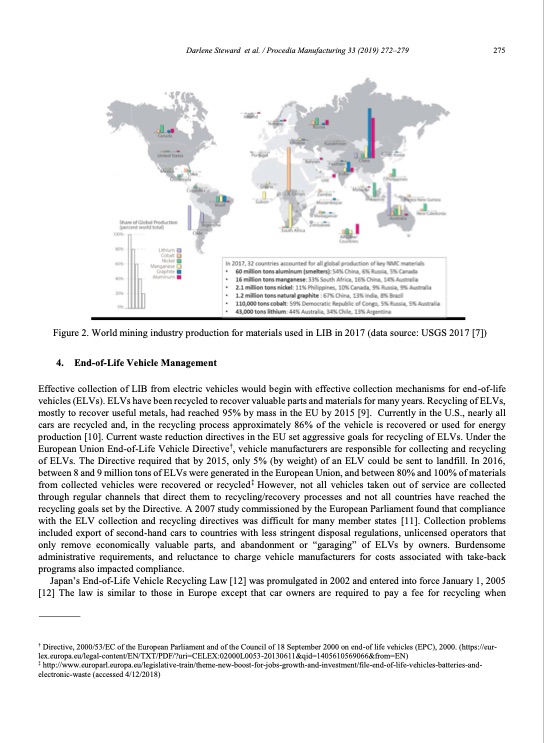
PDF Publication Title:
Text from PDF Page: 004
Darlene Steward et al. / Procedia Manufacturing 33 (2019) 272–279 275 4 Steward et al./ Procedia Manufacturing 00 (2018) 000–000 Figure 2. World mining industry production for materials used in LIB in 2017 (data source: USGS 2017 [7]) 4. End-of-Life Vehicle Management Effective collection of LIB from electric vehicles would begin with effective collection mechanisms for end-of-life vehicles (ELVs). ELVs have been recycled to recover valuable parts and materials for many years. Recycling of ELVs, mostly to recover useful metals, had reached 95% by mass in the EU by 2015 [9]. Currently in the U.S., nearly all cars are recycled and, in the recycling process approximately 86% of the vehicle is recovered or used for energy production [10]. Current waste reduction directives in the EU set aggressive goals for recycling of ELVs. Under the European Union End-of-Life Vehicle Directive†, vehicle manufacturers are responsible for collecting and recycling of ELVs. The Directive required that by 2015, only 5% (by weight) of an ELV could be sent to landfill. In 2016, between 8 and 9 million tons of ELVs were generated in the European Union, and between 80% and 100% of materials from collected vehicles were recovered or recycled‡ However, not all vehicles taken out of service are collected through regular channels that direct them to recycling/recovery processes and not all countries have reached the recycling goals set by the Directive. A 2007 study commissioned by the European Parliament found that compliance with the ELV collection and recycling directives was difficult for many member states [11]. Collection problems included export of second-hand cars to countries with less stringent disposal regulations, unlicensed operators that only remove economically valuable parts, and abandonment or “garaging” of ELVs by owners. Burdensome administrative requirements, and reluctance to charge vehicle manufacturers for costs associated with take-back programs also impacted compliance. Japan’s End-of-Life Vehicle Recycling Law [12] was promulgated in 2002 and entered into force January 1, 2005 [12] The law is similar to those in Europe except that car owners are required to pay a fee for recycling when † Directive, 2000/53/EC of the European Parliament and of the Council of 18 September 2000 on end-of life vehicles (EPC), 2000. (https://eur- lex.europa.eu/legal-content/EN/TXT/PDF/?uri=CELEX:02000L0053-20130611&qid=1405610569066&from=EN) ‡ http://www.europarl.europa.eu/legislative-train/theme-new-boost-for-jobs-growth-and-investment/file-end-of-life-vehicles-batteries-and- electronic-waste (accessed 4/12/2018)PDF Image | Li-ion battery recycling challenges

PDF Search Title:
Li-ion battery recycling challengesOriginal File Name Searched:
71350.pdfDIY PDF Search: Google It | Yahoo | Bing
NFT (Non Fungible Token): Buy our tech, design, development or system NFT and become part of our tech NFT network... More Info
IT XR Project Redstone NFT Available for Sale: NFT for high tech turbine design with one part 3D printed counter-rotating energy turbine. Be part of the future with this NFT. Can be bought and sold but only one design NFT exists. Royalties go to the developer (Infinity) to keep enhancing design and applications... More Info
Infinity Turbine IT XR Project Redstone Design: NFT for sale... NFT for high tech turbine design with one part 3D printed counter-rotating energy turbine. Includes all rights to this turbine design, including license for Fluid Handling Block I and II for the turbine assembly and housing. The NFT includes the blueprints (cad/cam), revenue streams, and all future development of the IT XR Project Redstone... More Info
Infinity Turbine ROT Radial Outflow Turbine 24 Design and Worldwide Rights: NFT for sale... NFT for the ROT 24 energy turbine. Be part of the future with this NFT. This design can be bought and sold but only one design NFT exists. You may manufacture the unit, or get the revenues from its sale from Infinity Turbine. Royalties go to the developer (Infinity) to keep enhancing design and applications... More Info
Infinity Supercritical CO2 10 Liter Extractor Design and Worldwide Rights: The Infinity Supercritical 10L CO2 extractor is for botanical oil extraction, which is rich in terpenes and can produce shelf ready full spectrum oil. With over 5 years of development, this industry leader mature extractor machine has been sold since 2015 and is part of many profitable businesses. The process can also be used for electrowinning, e-waste recycling, and lithium battery recycling, gold mining electronic wastes, precious metals. CO2 can also be used in a reverse fuel cell with nafion to make a gas-to-liquids fuel, such as methanol, ethanol and butanol or ethylene. Supercritical CO2 has also been used for treating nafion to make it more effective catalyst. This NFT is for the purchase of worldwide rights which includes the design. More Info
NFT (Non Fungible Token): Buy our tech, design, development or system NFT and become part of our tech NFT network... More Info
Infinity Turbine Products: Special for this month, any plans are $10,000 for complete Cad/Cam blueprints. License is for one build. Try before you buy a production license. May pay by Bitcoin or other Crypto. Products Page... More Info
| CONTACT TEL: 608-238-6001 Email: greg@infinityturbine.com | RSS | AMP |